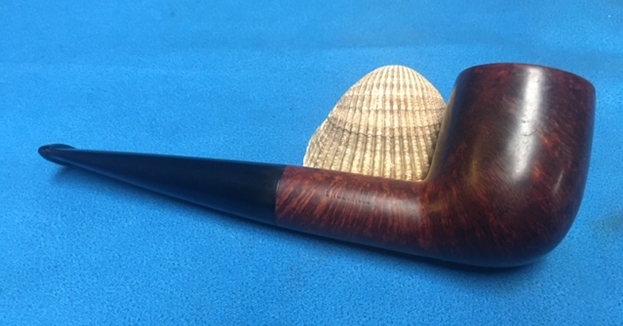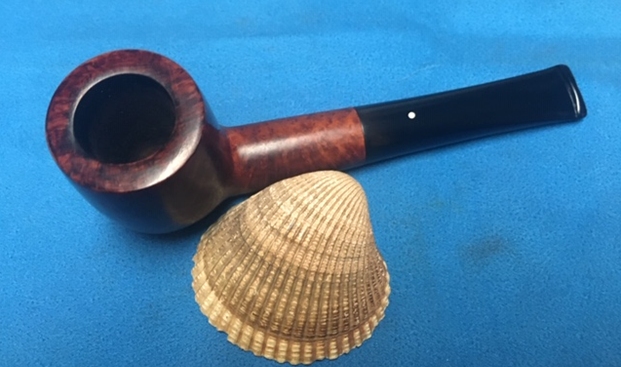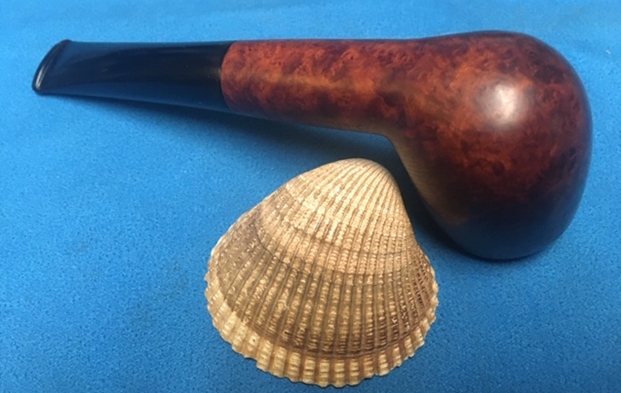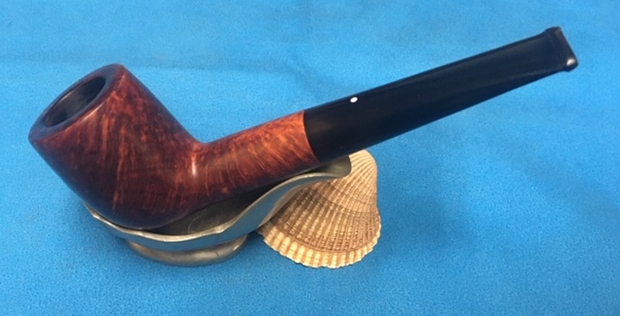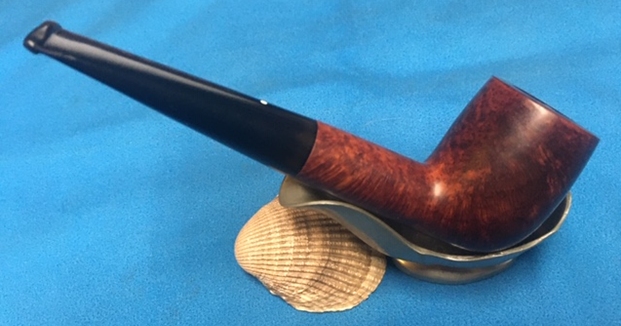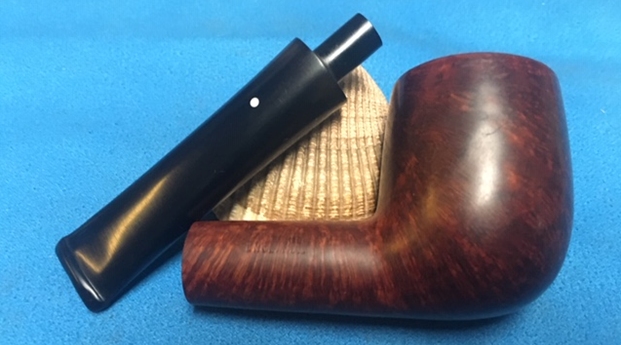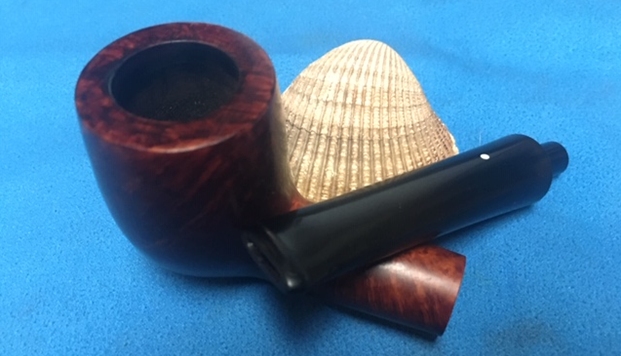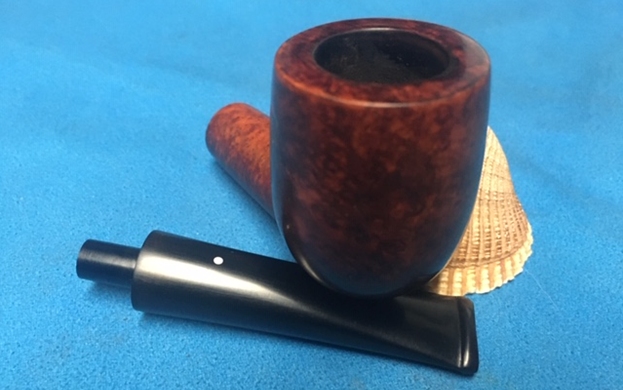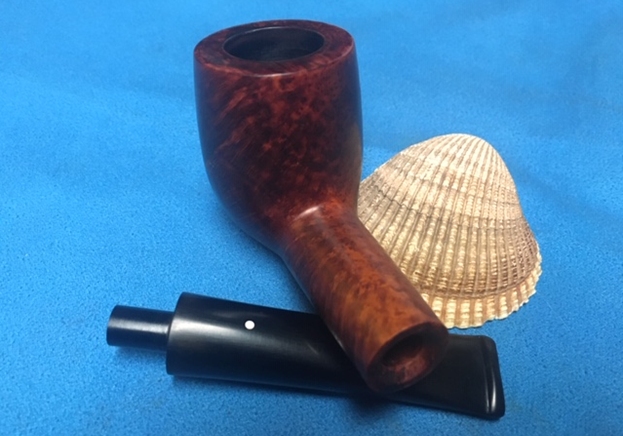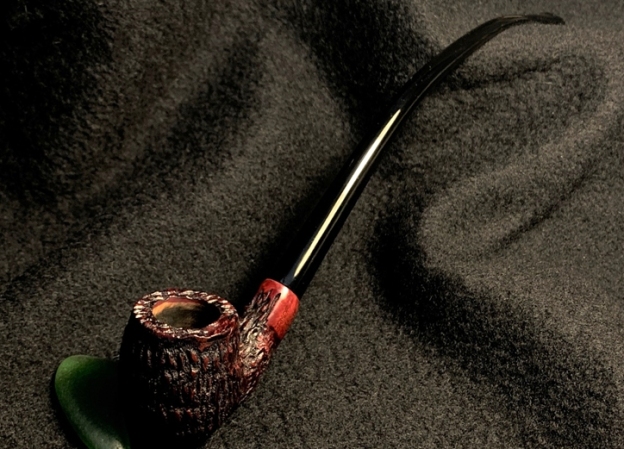Blog by Steve Laug
 As I continue to work through the pipes in Bob Kerr’s Estate I am enjoying choosing different brands that he had to focus on for a bit. I had eight more from his Dunhill collection that I decided to go back to and finish working my way through that sub collection of the estate. Out of the 8 pipes six were Bruyere finished pipes, one was a Made in London, and one was a Root Briar. What follows is a list of what I saw when I examined the 8 pipes. As I finish the pipes I will include the link to the blog on that particular pipe for easy reference. I have already restored 16 pipes from this subgroup so you can do a quick search to read about the work on the Shell Briars and Tanshell Briars that were in that part of the collection.
As I continue to work through the pipes in Bob Kerr’s Estate I am enjoying choosing different brands that he had to focus on for a bit. I had eight more from his Dunhill collection that I decided to go back to and finish working my way through that sub collection of the estate. Out of the 8 pipes six were Bruyere finished pipes, one was a Made in London, and one was a Root Briar. What follows is a list of what I saw when I examined the 8 pipes. As I finish the pipes I will include the link to the blog on that particular pipe for easy reference. I have already restored 16 pipes from this subgroup so you can do a quick search to read about the work on the Shell Briars and Tanshell Briars that were in that part of the collection.
- Bruyere 656 F/T Made in England 2 Circle 4A – Group 4 size Bruyere made in 1962. Stem is oxidized, tooth marks and chatter near the button, some calcification with damage to the button. Finish is dirty, bowl caked and lava overflow on the rim top. Bowl is out of round, damaged edge.
- Bruyere 112 F/T Made in England 9/11 Circle 2A – Group 2 size Bruyere made in 1969 and sold in 1971. Stem is oxidized, tooth marks and chatter near the button, some calcification with damage to the button. Finish is dirty, bowl caked and lava overflow on the rim top. Bowl is out of round, damaged edge.
- Bruyere 0333 Made in England 16 made in 1976. Stem is oxidized, tooth marks and chatter near the button, some calcification with damage to the button. Finish is dirty, bowl caked and lava overflow on the rim top. Bowl is out of round, damaged edge.
- Bruyere 41061 Made in England 18 made in 1978. Stem is oxidized, tooth marks and chatter near the button, some calcification with damage to the button. Finish is dirty, bowl caked and lava overflow on the rim top. Bowl is out of round, damaged edge.
- Bruyere 142 F/T Made in England 7/9/11 Circle 4A – Group for size Bruyere made in 1967 and sent out in 1969 or 1971. Stem is oxidized, tooth marks and chatter near the button, some calcification with damage to the button. Finish is dirty, bowl caked and lava overflow on the rim top. Bowl is out of round, damaged edge.
- Bruyere A Inner Tube Patent No. 5831412 Shape 34. Stem is oxidized, tooth marks and chatter near the button, some calcification with damage to the button. Finish is dirty, bowl caked and lava overflow on the rim top. Bowl is out of round, damaged edge. Missing the inner tube.
- Made in London 113 539/14. Stem is oxidized, tooth marks and chatter near the button, some calcification with damage to the button. Finish is dirty, bowl caked and lava overflow on the rim top. Bowl is out of round, damaged rim edges.
- Root Briar 31032 Made in England 18 – made in 1978. Stem is oxidized, tooth marks and chatter near the button, some calcification with damage to the button. Finish is dirty, bowl caked and lava overflow on the rim top. Bowl is out of round, damaged edge.
I chose to work on #8 next, the sole Root Briar pipe remaining in the collection. Paresh had picked up an earlier one that I had finished to add to his collection in India. The highest honor for a Dunhill pipe is to receive the prestigious Root Briar appellation. Root Briars have been coveted by pipesmokers ever since they first debuted in 1931, due to the fact that each pipe must boast briar completely free of even the most minor of blemishes. Dunhill has the strictest of standards and expectations for quality with all of their pipes, and so any block of briar that comes to bear the Root Briar stamp must indeed be superlative.
The pipe was stamped on the left side of the shank with the five digit shape number next to the bowl/shank junction. It read 31032. That is followed by Dunhill over Root Briar. On the right side of the shank it is stamped Made in England 18 which would make it a pipe made in 1978. The shape number code can be broken down to give a lot of information. Typically Dunhill pipes are stamped with a four digit code. The first digit (1-6) denotes the group size of the pipe. In this case it is a Group 3 sized pipe. The second digit denotes the style of the mouthpiece (0,1=tapered, 2=saddle). In this case it is a 1 which matches the tapered stem on the shank. The third and fourth digits give the generic shape in the chart below. I have captured part of the chart to identify this pipe as a 03 or a straight Billiard. When 5 digits occur, the meaning of the 4 first remains the same (http://www.pipephil.eu/logos/en/dunhill/shapes.html).  There was a thick cake in the bowl with remnants of tobacco stuck on the walls. There was a lava overflow on the rim. The top and edges of the rim appear to be in good condition though there appears to be a little burn damage on the left front inner edge of the bowl. The outer edge looks very good. The grain on this is beautiful – diagonal or flame grain and some birdseye on the heel of the bowl. I think that there is a beautiful pipe underneath all of the buildup of years of use. The sides of the bowl had some darkening from oils and tars. The stem was oxidized and calcified toward the end with some tooth chatter. There were also some tooth marks on both sides of the stem ahead of the button and on the button itself. There was the classic White Spot on the top of the stem. Jeff took photos of the pipe before he started his cleanup work on it.
There was a thick cake in the bowl with remnants of tobacco stuck on the walls. There was a lava overflow on the rim. The top and edges of the rim appear to be in good condition though there appears to be a little burn damage on the left front inner edge of the bowl. The outer edge looks very good. The grain on this is beautiful – diagonal or flame grain and some birdseye on the heel of the bowl. I think that there is a beautiful pipe underneath all of the buildup of years of use. The sides of the bowl had some darkening from oils and tars. The stem was oxidized and calcified toward the end with some tooth chatter. There were also some tooth marks on both sides of the stem ahead of the button and on the button itself. There was the classic White Spot on the top of the stem. Jeff took photos of the pipe before he started his cleanup work on it.
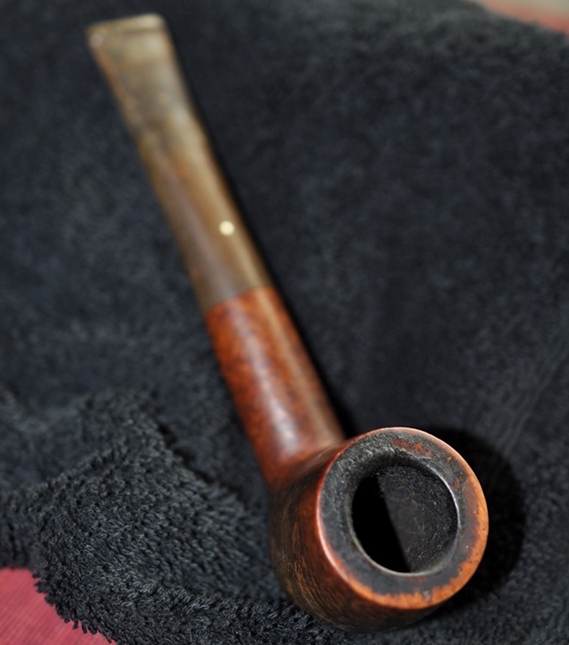 Jeff took photos of the bowl and rim top to show the thick, hard cake in the bowl with remnants of tobacco stuck on the walls of the bowl. There was a lava build up on the smooth rim top and the edges of the bowl. The rim top looked pretty good but it was hard to know for sure. It appeared that there was damage at the back and the front of the inner edge. The outer edges looked good.
Jeff took photos of the bowl and rim top to show the thick, hard cake in the bowl with remnants of tobacco stuck on the walls of the bowl. There was a lava build up on the smooth rim top and the edges of the bowl. The rim top looked pretty good but it was hard to know for sure. It appeared that there was damage at the back and the front of the inner edge. The outer edges looked good. 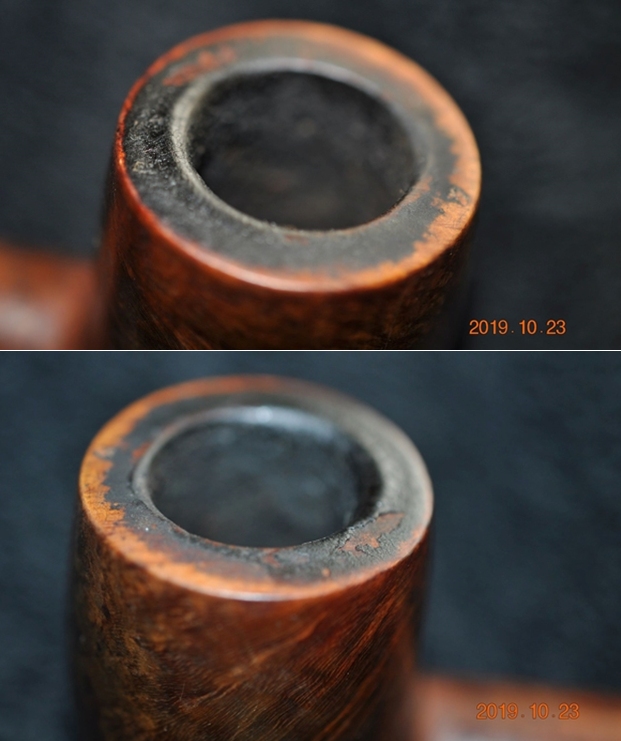 Jeff took photos of the side and heel of the bowl to show the condition of the finish. You can see the beautiful grain patterns around the sides of the bowl and shank. Even under the dirt and debris of the years it looked very good.
Jeff took photos of the side and heel of the bowl to show the condition of the finish. You can see the beautiful grain patterns around the sides of the bowl and shank. Even under the dirt and debris of the years it looked very good. The stamping is readable and on the left side of the shank you can see the shape number 31032 as noted above followed by Dunhill over Root Briar. On the right side it reads Made In England with the date stamp 18 after the D in England. He included a pic of the White Spot on the stem.
The stamping is readable and on the left side of the shank you can see the shape number 31032 as noted above followed by Dunhill over Root Briar. On the right side it reads Made In England with the date stamp 18 after the D in England. He included a pic of the White Spot on the stem. 
 Jeff took photos of the top and underside of the stem showing the tooth chatter, scratching and oxidation on the stem surface and wear on the edges of the button.
Jeff took photos of the top and underside of the stem showing the tooth chatter, scratching and oxidation on the stem surface and wear on the edges of the button. I am really happy to have Jeff’s help on cleaning up the pipes from Bob’s estate as the 125+ pipes were taking me a long time to do alone. He cleaned this filthy pipe with his usual penchant for thoroughness that I really appreciate. This one was a real mess and I was looking forward to seeing what he had done with this one when I took it out of his box. It looked amazing and CLEAN. He reamed it with a PipNet pipe reamer and cleaned up the reaming with a Savinelli Fitsall Pipe Knife. He scrubbed out the internals with alcohol, pipe cleaners and cotton swabs until the pipe was clean. He scrubbed the exterior of the bowl with Murphy’s Oil Soap and a tooth brush to remove the grime and grit on the briar and the lava on the rim top. The finish looks very good with great looking grain around the bowl and shank. It looked like there were some dents in the briar on the right side of the bowl that would need to be dealt with. The stem looked a lot better. Jeff soaked the stem in Before & After Deoxidizer to remove the oxidation on the rubber. The pipe was ready for me to carry on the next part of the process.
I am really happy to have Jeff’s help on cleaning up the pipes from Bob’s estate as the 125+ pipes were taking me a long time to do alone. He cleaned this filthy pipe with his usual penchant for thoroughness that I really appreciate. This one was a real mess and I was looking forward to seeing what he had done with this one when I took it out of his box. It looked amazing and CLEAN. He reamed it with a PipNet pipe reamer and cleaned up the reaming with a Savinelli Fitsall Pipe Knife. He scrubbed out the internals with alcohol, pipe cleaners and cotton swabs until the pipe was clean. He scrubbed the exterior of the bowl with Murphy’s Oil Soap and a tooth brush to remove the grime and grit on the briar and the lava on the rim top. The finish looks very good with great looking grain around the bowl and shank. It looked like there were some dents in the briar on the right side of the bowl that would need to be dealt with. The stem looked a lot better. Jeff soaked the stem in Before & After Deoxidizer to remove the oxidation on the rubber. The pipe was ready for me to carry on the next part of the process. 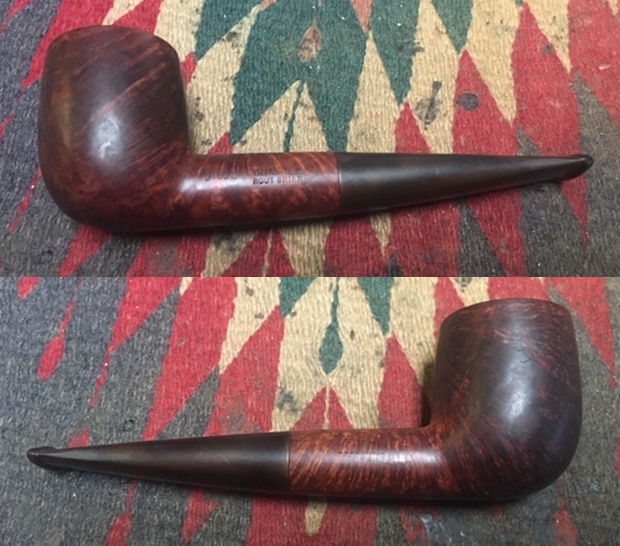
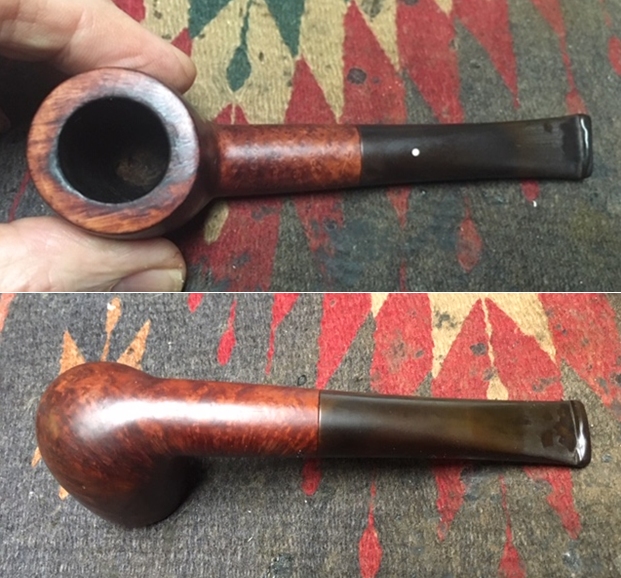 I took some close up photos of the rim top and also of the stem surface. I wanted to show how well it had cleaned up and what needed to be done. The rim top had some darkening toward the back of the bowl and on the inner edge. There was also some burn damage on the front inner edge of the bowl. The outer edge looked very good. I also took close up photos of the stem to show the tooth marks and chatter on the stem surface.
I took some close up photos of the rim top and also of the stem surface. I wanted to show how well it had cleaned up and what needed to be done. The rim top had some darkening toward the back of the bowl and on the inner edge. There was also some burn damage on the front inner edge of the bowl. The outer edge looked very good. I also took close up photos of the stem to show the tooth marks and chatter on the stem surface.  The stamping appeared to be as clear as ever on the shank sides. This is just one of the things I appreciate about Jeff’s cleanup is that he works to protect and preserve the nomenclature on the shank of the pipes that he works on. I took some photos to show the stamping.
The stamping appeared to be as clear as ever on the shank sides. This is just one of the things I appreciate about Jeff’s cleanup is that he works to protect and preserve the nomenclature on the shank of the pipes that he works on. I took some photos to show the stamping. 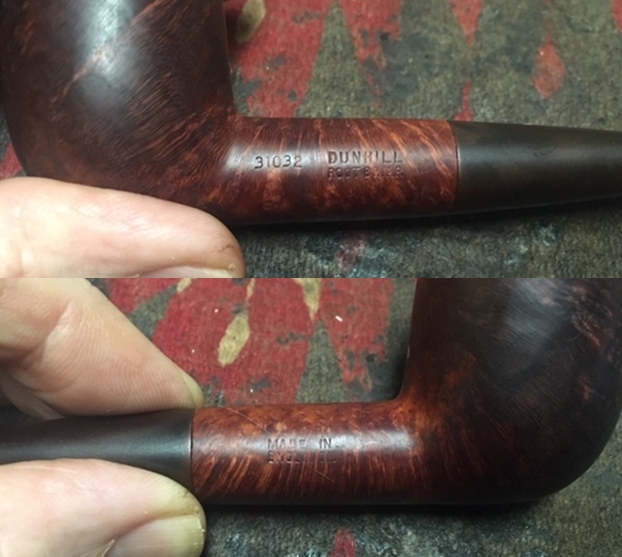
 Bob loved his Dunhill pipes and it was obvious that he enjoyed smoking them. Some appeared to be daily smokes while others he seemed to reserve for special occasions. Some seemed like they must have hung in his mouth while he did his carving while others were smoked in his chair. Having worked on over 60 of his pipes so far I am getting a feel for them.
Bob loved his Dunhill pipes and it was obvious that he enjoyed smoking them. Some appeared to be daily smokes while others he seemed to reserve for special occasions. Some seemed like they must have hung in his mouth while he did his carving while others were smoked in his chair. Having worked on over 60 of his pipes so far I am getting a feel for them.
I am sure that many of you have read at least some of the other restoration work that I have done on previous pipes. You have also read what I have included about Bob Kerr, the pipeman who held these pipes in trust before I came to work on them (see photo to the left). Also, if you have followed the blog for long you will already know that I like to include background information on the pipeman whose pipes I am restoring. For me, when I am working on an estate I really like to have a sense of the person who held the pipes in trust before I worked on them. It gives me another dimension of the restoration work. Bob’s daughter wrote a short tribute to her father. I thank you Brian and tell your wife thank you as well.
I am delighted to pass on these beloved pipes of my father’s. I hope each user gets many hours of contemplative pleasure as he did. I remember the aroma of tobacco in the rec room, as he put up his feet on his lazy boy. He’d be first at the paper then, no one could touch it before him. Maybe there would be a movie on with an actor smoking a pipe. He would have very definite opinions on whether the performer was a ‘real’ smoker or not, a distinction which I could never see but it would be very clear to him. He worked by day as a sales manager of a paper products company, a job he hated. What he longed for was the life of an artist, so on the weekends and sometimes mid-week evenings he would journey to his workshop and come out with wood sculptures, all of which he declared as crap but every one of them treasured by my sister and myself. Enjoy the pipes, and maybe a little of his creative spirit will enter you!
It was time to get on with the restoration of this beautiful and worn Dunhill Root Briar Billiard. I really appreciate the hard cleanup work that Jeff did on these pipes. They were a real mess when I sent them to Jeff and I have to tell you it was great that I did not need to clean this pipe. I decided to start the process by dealing with the dents in the briar on both sides of the bowl. I heated a knife with the flame on our gas stove and dampened a cloth. I put the cloth over the dents and applied the hot knife to the surface. The heat generated steam and lifted the dents. I applied the knife several times before I was happy with the look of the bowl. 
 I then went on to address the damage to the inner edge of the bowl. I worked on the inner edge with a folded piece of 220 grit sandpaper and gave it a very slight bevel. I was able to remove much of the damage. There was still a slight “dip” in the edge at the front. The photos show the progress.
I then went on to address the damage to the inner edge of the bowl. I worked on the inner edge with a folded piece of 220 grit sandpaper and gave it a very slight bevel. I was able to remove much of the damage. There was still a slight “dip” in the edge at the front. The photos show the progress. 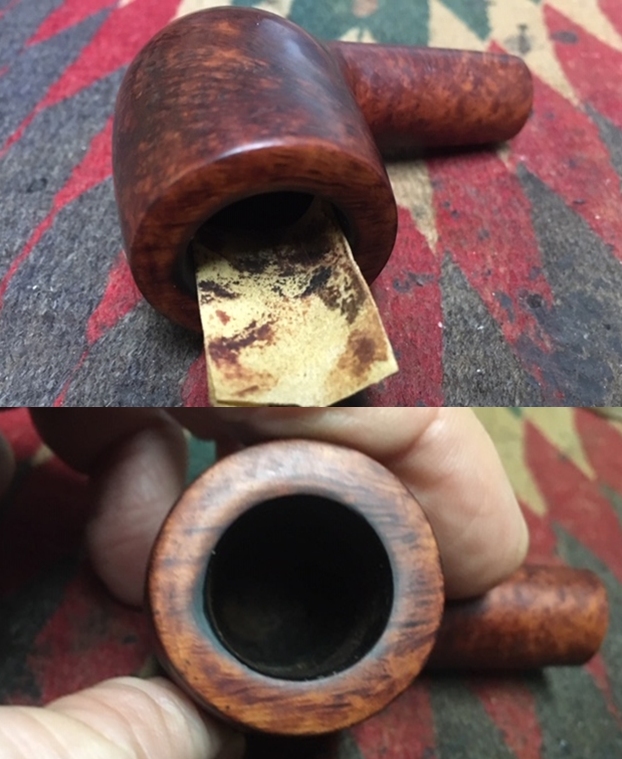 I polished the briar on the rim top with micromesh sanding pads – wet sanding it with 1500-4000 grit pads and I wiped the bowl down after each sanding pad with a damp cloth. The grain progressively stood out as I polished the pipe with the pads.
I polished the briar on the rim top with micromesh sanding pads – wet sanding it with 1500-4000 grit pads and I wiped the bowl down after each sanding pad with a damp cloth. The grain progressively stood out as I polished the pipe with the pads. 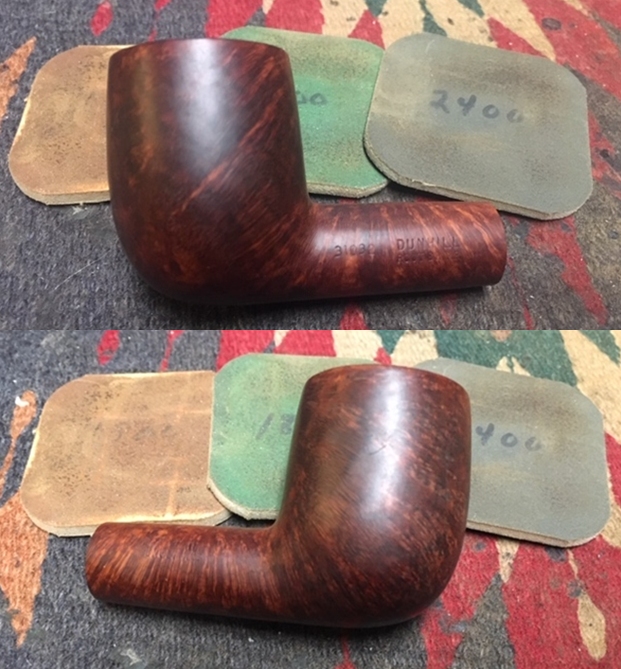
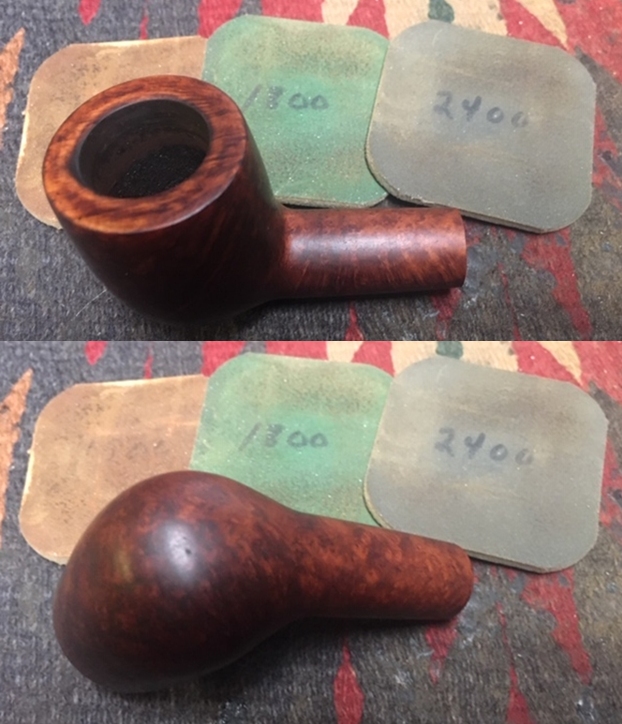

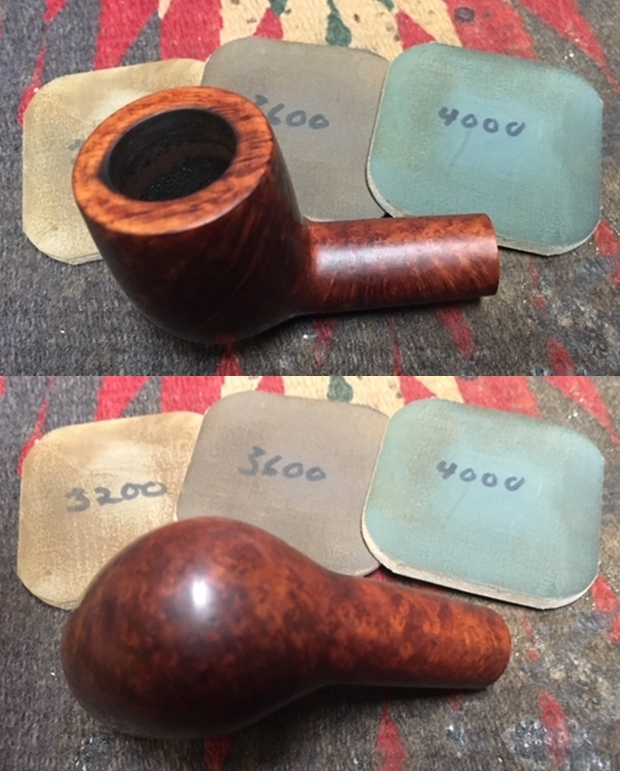 I paused the polishing to restain the rim top to match the rest of the pipe. I used a walnut stain pen and was able to get the match. The rim top would need to be polished but the colour was right so time would tell.
I paused the polishing to restain the rim top to match the rest of the pipe. I used a walnut stain pen and was able to get the match. The rim top would need to be polished but the colour was right so time would tell. I continued to polish the bowl with 6000-12000 grit micromesh sanding pads. I wiped it down after each pad with a damp cloth.
I continued to polish the bowl with 6000-12000 grit micromesh sanding pads. I wiped it down after each pad with a damp cloth. 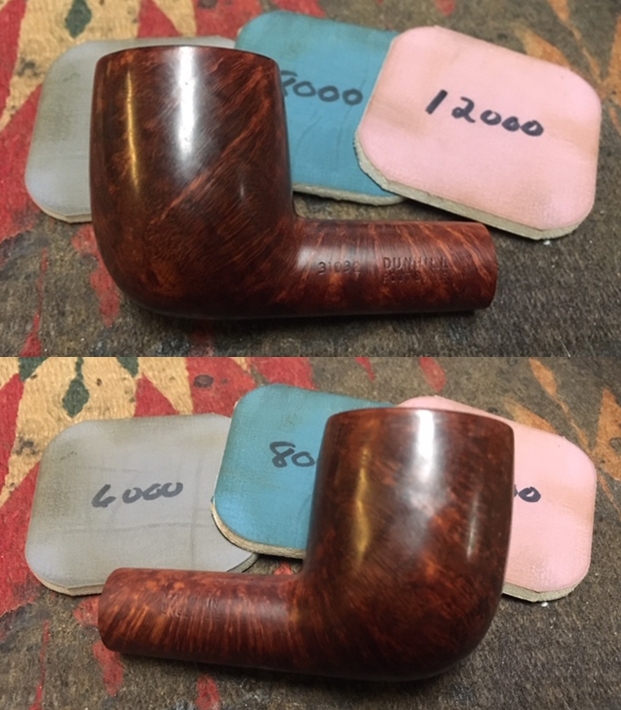
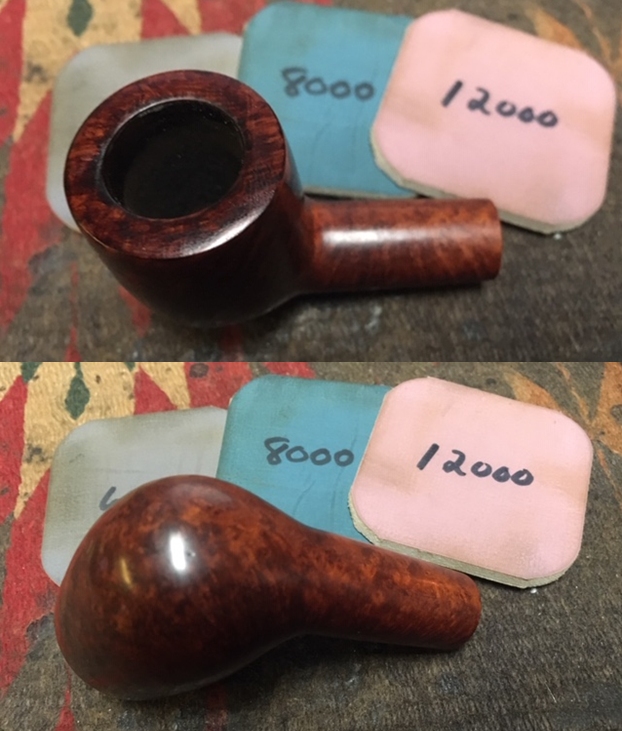 I rubbed the bowl and rim down with Before & After Restoration Balm. I worked it into the surface of the briar with my fingertips to clean, enliven and protect it. I let the balm sit for a little while and then buffed the pipe with a cotton cloth to raise the shine. I really like watching the Balm do its magic and bring the briar alive.
I rubbed the bowl and rim down with Before & After Restoration Balm. I worked it into the surface of the briar with my fingertips to clean, enliven and protect it. I let the balm sit for a little while and then buffed the pipe with a cotton cloth to raise the shine. I really like watching the Balm do its magic and bring the briar alive. 

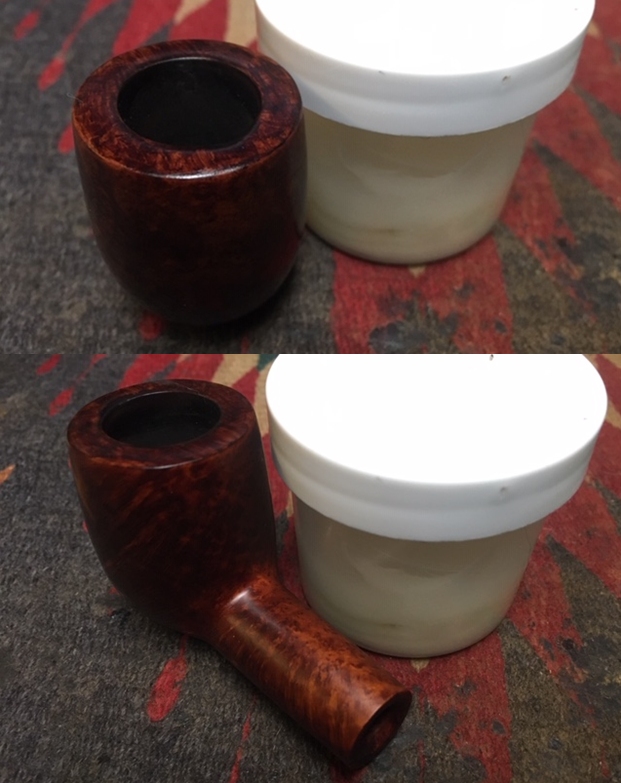 With the bowl done it was time to address the stem. The dents in the top and underside were the right depth for me to lift them. I “painted” the surface of the stem with the flame of a Bic lighter to raise the dents in the surface. I was able to lift most of them to the point that a repair would be less complex.
With the bowl done it was time to address the stem. The dents in the top and underside were the right depth for me to lift them. I “painted” the surface of the stem with the flame of a Bic lighter to raise the dents in the surface. I was able to lift most of them to the point that a repair would be less complex.  I filled in the damaged areas on the button edge and the small remaining dents in the underside of the stem with clear Krazy Glue.
I filled in the damaged areas on the button edge and the small remaining dents in the underside of the stem with clear Krazy Glue.  Once the repair had cured I used a flat needle file to reshape the button and edges. The stem is starting to take shape.
Once the repair had cured I used a flat needle file to reshape the button and edges. The stem is starting to take shape. 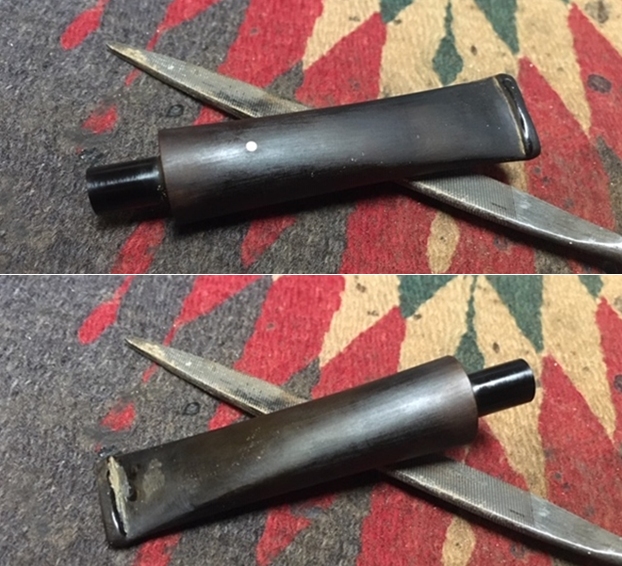 I sanded the surface of the stem with 220 grit sandpaper to remove the remaining oxidation in the vulcanite. I polished it with 400 grit wet dry sand paper.
I sanded the surface of the stem with 220 grit sandpaper to remove the remaining oxidation in the vulcanite. I polished it with 400 grit wet dry sand paper. 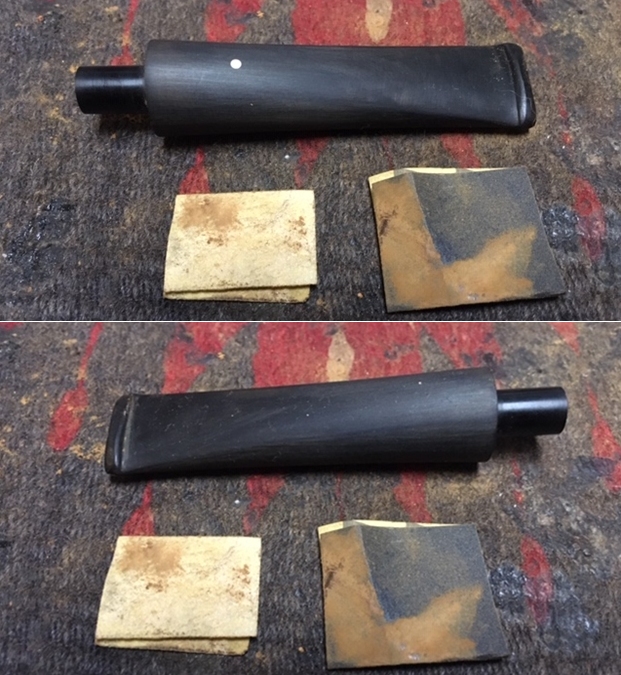 I rubbed the stem down with Denicare Mouthpiece Polish. I have a few tins of this laying around so I am trying to use them up. It does a pretty good job polishing the stem.
I rubbed the stem down with Denicare Mouthpiece Polish. I have a few tins of this laying around so I am trying to use them up. It does a pretty good job polishing the stem. 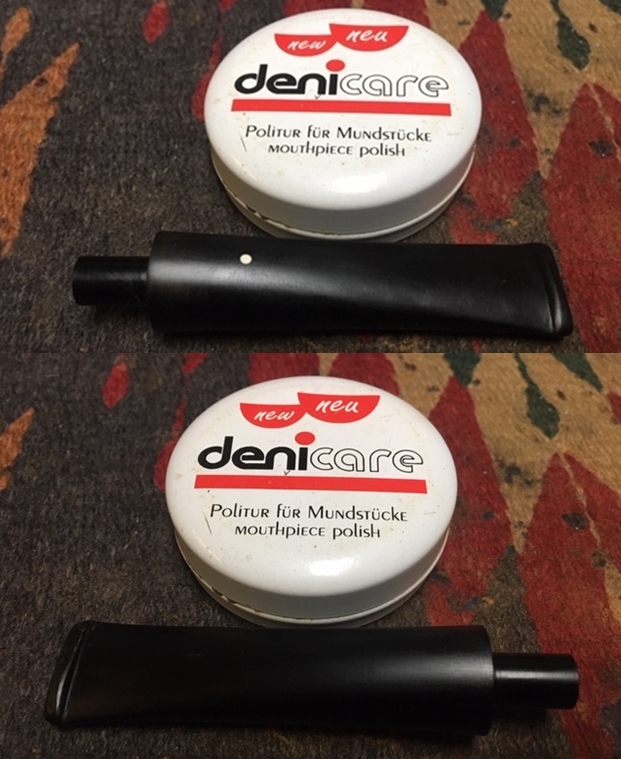 I polished the stem with micromesh sanding pads – wet sanding with 1500-12000 grit sanding pads. I wiped it down after each pad with a damp cloth to remove the sanding dust. I polished it further with Before & After Pipe Polish – both Fine and Extra Fine. I finished by rubbing the stem down with some “No Oxy Oil” to protect the vulcanite. I am experimenting with the product from Briarville and tracking how it works so I can write a review of it.
I polished the stem with micromesh sanding pads – wet sanding with 1500-12000 grit sanding pads. I wiped it down after each pad with a damp cloth to remove the sanding dust. I polished it further with Before & After Pipe Polish – both Fine and Extra Fine. I finished by rubbing the stem down with some “No Oxy Oil” to protect the vulcanite. I am experimenting with the product from Briarville and tracking how it works so I can write a review of it. 
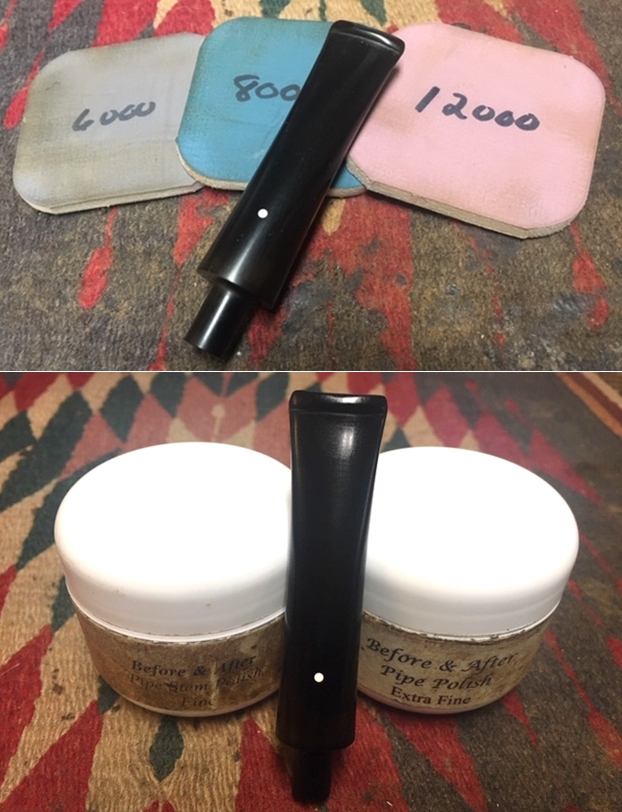
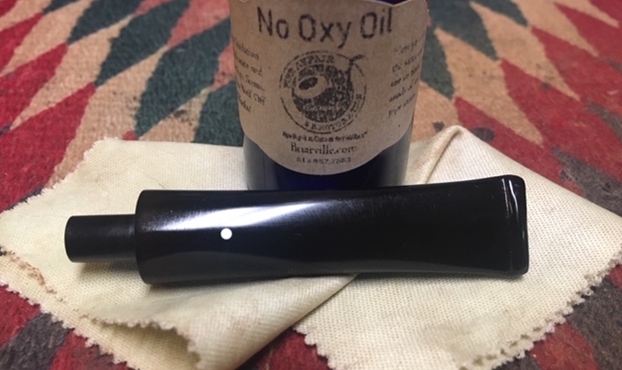 Once again at this point in the restoration process I am excited to be on the homestretch. This is the first of the Dunhill smooth pipes in Bob’s estate that I am working on. It is a beautiful Root Briar 31032 Billiard. I always look forward to this point in the process when it is put back together, polished and waxed. I put the bowl and stem back together. I polished the bowl and stem with Blue Diamond to polish out the scratches in the briar and the vulcanite. I gave the bowl and the stem multiple coats of carnauba wax. I buffed the pipe with a clean buffing pad to raise the shine. I hand buffed it with a microfiber cloth to deepen the shine. The pipe polished up pretty nicely. The grain around the bowl and shank really came alive with the wax and polish. The black of the tapered vulcanite White Spot stem is a beautiful contrast to the browns of the finished bowl and shank. This is Dunhill was a lot of fun to work on thanks to Jeff’s cleanup work. The pipe is comfortable pipe to hold in the hand. The finished pipe is shown in the photos below. The dimensions of the pipe are Length: 5 ¼ inches, Height: 1 ¾ inches, Outside diameter of the bowl: 1 ¼ inches, Chamber diameter: ¾ of an inch. This 78 Root Briar Billiard is a beauty that I am still trying to figure out whether to sell it or buy it. It will take a bit of time and once I decide I will either enjoy it or it will be going on the rebornpipes store. I have a lot more of Bob’s estate to work on of various brands. Perhaps one of those will catch your attention. Thanks for reading this blog and my reflections on the pipe while I worked on it. This is an interesting estate to bring back to life.
Once again at this point in the restoration process I am excited to be on the homestretch. This is the first of the Dunhill smooth pipes in Bob’s estate that I am working on. It is a beautiful Root Briar 31032 Billiard. I always look forward to this point in the process when it is put back together, polished and waxed. I put the bowl and stem back together. I polished the bowl and stem with Blue Diamond to polish out the scratches in the briar and the vulcanite. I gave the bowl and the stem multiple coats of carnauba wax. I buffed the pipe with a clean buffing pad to raise the shine. I hand buffed it with a microfiber cloth to deepen the shine. The pipe polished up pretty nicely. The grain around the bowl and shank really came alive with the wax and polish. The black of the tapered vulcanite White Spot stem is a beautiful contrast to the browns of the finished bowl and shank. This is Dunhill was a lot of fun to work on thanks to Jeff’s cleanup work. The pipe is comfortable pipe to hold in the hand. The finished pipe is shown in the photos below. The dimensions of the pipe are Length: 5 ¼ inches, Height: 1 ¾ inches, Outside diameter of the bowl: 1 ¼ inches, Chamber diameter: ¾ of an inch. This 78 Root Briar Billiard is a beauty that I am still trying to figure out whether to sell it or buy it. It will take a bit of time and once I decide I will either enjoy it or it will be going on the rebornpipes store. I have a lot more of Bob’s estate to work on of various brands. Perhaps one of those will catch your attention. Thanks for reading this blog and my reflections on the pipe while I worked on it. This is an interesting estate to bring back to life.
